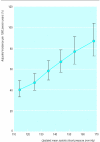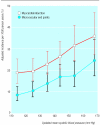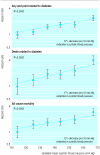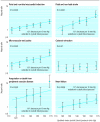Association of systolic blood pressure with macrovascular and microvascular complications of type 2 diabetes (UKPDS 36): prospective observational study
- PMID: 10938049
- PMCID: PMC27455
- DOI: 10.1136/bmj.321.7258.412
Association of systolic blood pressure with macrovascular and microvascular complications of type 2 diabetes (UKPDS 36): prospective observational study
Abstract
Objective: To determine the relation between systolic blood pressure over time and the risk of macrovascular or microvascular complications in patients with type 2 diabetes.
Design: Prospective observational study.
Setting: 23 hospital based clinics in England, Scotland, and Northern Ireland.
Participants: 4801 white, Asian Indian, and Afro-Caribbean UKPDS patients, whether randomised or not to treatment, were included in analyses of incidence; of these, 3642 were included in analyses of relative risk.
Outcome measures: Primary predefined aggregate clinical outcomes: any complications or deaths related to diabetes and all cause mortality. Secondary aggregate outcomes: myocardial infarction, stroke, lower extremity amputation (including death from peripheral vascular disease), and microvascular disease (predominantly retinal photocoagulation). Single end points: non-fatal heart failure and cataract extraction. Risk reduction associated with a 10 mm Hg decrease in updated mean systolic blood pressure adjusted for specific confounders.
Results: The incidence of clinical complications was significantly associated with systolic blood pressure, except for cataract extraction. Each 10 mm Hg decrease in updated mean systolic blood pressure was associated with reductions in risk of 12% for any complication related to diabetes (95% confidence interval 10% to 14%, P<0.0001), 15% for deaths related to diabetes (12% to 18%, P<0.0001), 11% for myocardial infarction (7% to 14%, P<0.0001), and 13% for microvascular complications (10% to 16%, P<0.0001). No threshold of risk was observed for any end point.
Conclusions: In patients with type 2 diabetes the risk of diabetic complications was strongly associated with raised blood pressure. Any reduction in blood pressure is likely to reduce the risk of complications, with the lowest risk being in those with systolic blood pressure less than 120 mm Hg.
Figures




Comment in
-
Controlling glucose and blood pressure in type 2 diabetes.BMJ. 2000 Aug 12;321(7258):394-5. doi: 10.1136/bmj.321.7258.394. BMJ. 2000. PMID: 10938030 Free PMC article. No abstract available.
-
Glycaemia and vascular effects of type 2 diabetes. Relation between diabetes and hyperglycaemia and cardiovascular disease has not been resolved.BMJ. 2001 May 19;322(7296):1246-7. BMJ. 2001. PMID: 11388183 No abstract available.
-
Glycaemia and vascular effects of type 2 diabetes. UKPDS is not a cohort study and analysis is misleading.BMJ. 2001 May 19;322(7296):1246; author reply 1247. BMJ. 2001. PMID: 11388184 No abstract available.
References
-
- Klein R. Hyperglycemia and microvascular and macrovascular disease in diabetes. Diabetes Care. 1995;18:258–268. - PubMed
-
- Standl E, Balletshofer B, Dahl B, Weichenhain B, Stiegler, Hormann A, et al. Predictors of 10-year macrovascular and overall mortality in patients with NIDDM: the Munich general practitioner project. Diabetologia. 1996;39:1540–1545. - PubMed
-
- Hanefeld M, Fischer S, Julius U, Schulze J, Schwanebeck U, Schmechel H, et al. Risk factors for myocardial infarction and death in newly detected NIDDM: the diabetes intervention study, 11-year follow-up. Diabetologia. 1996;39:1577–1583. - PubMed
Publication types
MeSH terms
LinkOut - more resources
Full Text Sources
Other Literature Sources
Medical
